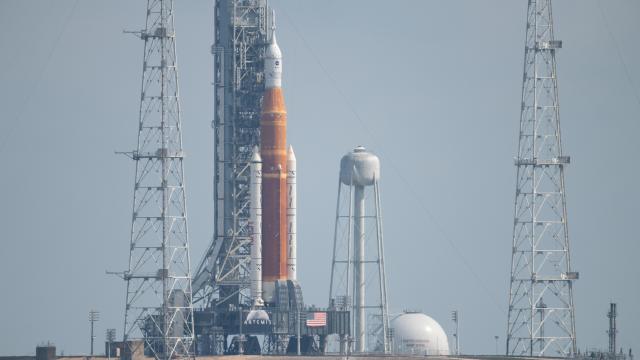The wet dress rehearsal of NASA’s Space Launch System has restarted following an eventful weekend at Kennedy Space Centre in Florida. In addition to dealing with multiple lightning strikes, mission managers had to contend with malfunctioning ventilation fans and a problem with the gaseous nitrogen system.
The decision to resume the wet dress rehearsal came at dawn today, with NASA Ground Systems saying the launch director would soon give the “go” for tanking and that weather shouldn’t be a problem. The 98-metre rocket is currently standing on Launch Pad 39B at Kennedy Space Centre in Florida, as NASA teams execute a full-fledged launch rehearsal that will stop 10 seconds prior to the ignition of four RS-25 engines.
Live video coverage of the wet dress rehearsal is available at the Kennedy Space Centre YouTube channel, but commentary is light given security concerns.
SLS is a critical component of the upcoming Artemis missions to the Moon, but the program has suffered from budget overruns and scheduling delays. The wet dress rehearsal is in preparation for the rocket’s inaugural launch, the Artemis 1 mission, in which an uncrewed Orion capsule will travel to the Moon and back. A crewed mission to the Moon is expected no earlier than 2025.
The wet dress was supposed to have ended yesterday, but controllers were forced to press pause on account of two malfunctioning fans, which ventilate the rocket’s 113-metre mobile launcher. The fans “are needed to provide positive pressure to the enclosed areas within the mobile launcher and keep out hazardous gases,” and “without this capability, technicians were unable to safely proceed with remotely loading the propellants into the rocket’s core stage and interim cryogenic propulsion stage,” according to a NASA update.
The scrub came shortly before noon on April 3, preventing teams from loading cryogenic liquid hydrogen and liquid oxygen into the rocket’s core and upper stages. NASA stopped the clock at T-minus 6 hours and 40 minutes to give its ground teams the time needed to troubleshoot the anomaly.
(1/4) 1 of the strikes last night was the strongest we have seen since we installed the new lightning protection system. It hit the catenary wire that runs between the 3 towers. System performed extremely well & kept SLS and Orion safe. Glad we enhanced protection since Shuttle!
— NASA’s Exploration Ground Systems (@NASAGroundSys) April 3, 2022
The malfunctioning fans were not related to four lightning strikes that hit the launch pad late Saturday afternoon, resulting in a slight delay. Lightning towers at the pad were hit three times during the electrical storm, while a fourth struck the catenary wiring system that channels electricity away from the rocket while it stands exposed. NASA checked the rocket and all systems, determining that it was safe to proceed with the wet dress.
Lightning strikes the umbilical tower of NASA’s new SLS rocket #Artemis #SLS #Lightning pic.twitter.com/lkuAzvUyLK
— Jerry Pike (@JerryPikePhoto) April 2, 2022
The countdown clock resumed at 10:52 a.m. EDT today. NASA is now targeting a T-0 at 6:02 p.m. EDT. NASA’s Exploration Ground Systems says the team resolved the issue with the fans as well as an earlier issue with the system that supplies gaseous nitrogen. The tanking of the rocket’s two stages, which happens sequentially, should take around 4.5 hours to complete. As this is happening, the team will perform checks to make sure the propellant is loading as expected and that the rocket hasn’t sprung any leaks.
We are “go” for tanking. @NASAKennedy teams will soon begin loading the @NASA_SLS rocket with fuel and conduct leak checks to make sure the tanking is proceeding as expected. Follow @NASAGroundSys for real-time updates: https://t.co/vNGEnCnOCv pic.twitter.com/I3ui1QUBgc
— NASA Artemis (@NASAArtemis) April 4, 2022
Ground controllers also plan to rehearse launch recycling, in which the clock is deliberately stopped and restarted. Once testing is complete, the tanks will be drained of propellant and the rocket will be carted back to the Vehicle Assembly Building for final modifications and check-outs.
Assuming the successful completion of a wet dress rehearsal, NASA will review the results, and, depending on how things went, announce a formal launch date for the Artemis 1 mission. Current expectations are that the megarocket will launch in early June, but since that the wet dress didn’t go exactly as planned, this will likely be pushed forward.
Editor’s Note: Release dates within this article are based in the U.S., but will be updated with local Australian dates as soon as we know more.
